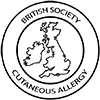Chlorhexidine
What are the aims of this patient information leaflet?
This leaflet has been written to help you understand more about your contact allergy. It tells you what a contact allergy is, what causes this allergy and what you can do about it.
What is contact allergy?
Dermatitis, also known as eczema, describes a type of inflammation of the skin. Contact dermatitis or contact eczema is a term used when this inflammation is caused by direct or indirect skin contact with something in your environment. Allergic contact dermatitis occurs when your immune system causes allergy to a very specific chemical or substance that has been in contact with the skin.
What causes your specific allergy?
Your patch tests indicate that you have a contact allergy to chlorhexidine.
What is chlorhexidine?
Chlorhexidine is an antiseptic chemical found in disinfection solutions, cosmetics, hand cleansers and wound cleansers.
What are some products that contain chlorhexidine?
- Eye drops, toothpastes and mouthwashes
- Some ‘moisturising’ skin washes
- Hospitals can use it to clean a patient’s skin before surgery, to genital skin before gynaecological procedures and to wash out bladders if there is infection
- Chlorhexidine mouth wash (generic); Corsodyl®; Periogard ® (mouth washes)
- Nystaform-HC ® (mild steroid and antiseptic cream)
- Cepton® , Hibiscrub® , Hibbi liquid hand rub®, Hydrex® , Hibitane® obstetric cream (surgical scrubs/ pre-surgery skin preparation)
- Naseptin cream® (antibiotic cream for the nostrils)
- Eczemol ® cream, Dermol ® cream, Dermol 200 ®, Dermol 500 ® (antiseptic emollient washes)
- Instillagel®.
Remember, always check the label, these lists can never be complete and ingredients change.
How can I manage my allergy?
This means that you should avoid putting products containing chlorhexidine onto your skin in the future.
Very rarely, people can have an rapid onset serious allergic reaction (immediate allergy) to chlorhexidine. This allergy is usually unrelated to eczema rashes (delayed allergy).
Self-care (what can I do?)
Always check the ingredient listing on the product, package or package insert as these lists can never be complete and ingredients change. This is particularly important for any products purchased outside the EU where some allergens may not be banned.
Created: 2017

